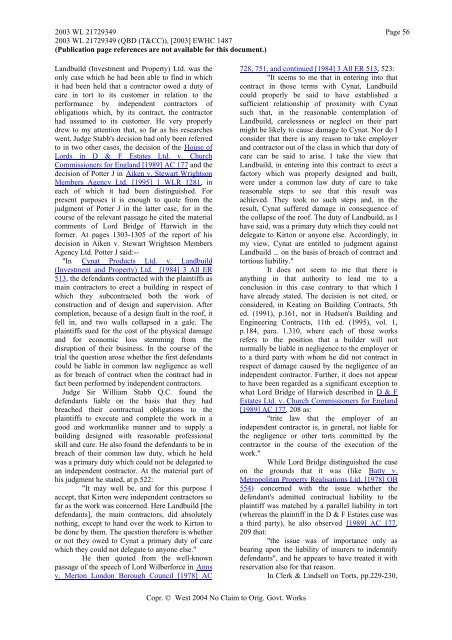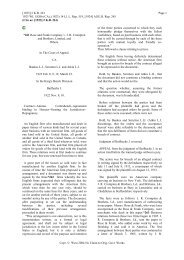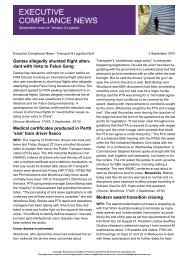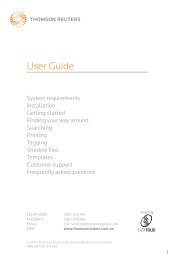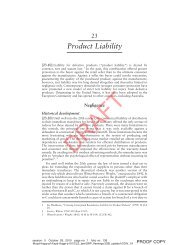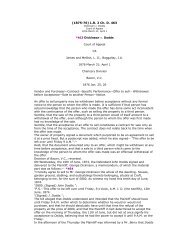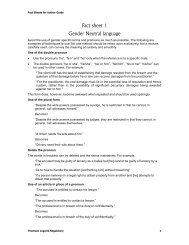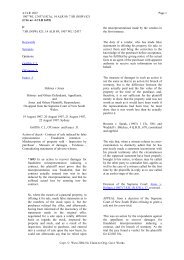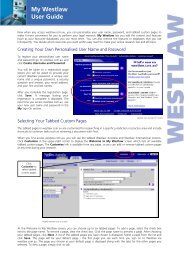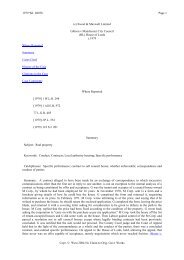Tesco v Constain - Thomson Reuters
Tesco v Constain - Thomson Reuters
Tesco v Constain - Thomson Reuters
You also want an ePaper? Increase the reach of your titles
YUMPU automatically turns print PDFs into web optimized ePapers that Google loves.
2003 WL 21729349 Page 562003 WL 21729349 (QBD (T&CC)), [2003] EWHC 1487(Publication page references are not available for this document.)Landbuild (Investment and Property) Ltd. was theonly case which he had been able to find in whichit had been held that a contractor owed a duty ofcare in tort to its customer in relation to theperformance by independent contractors ofobligations which, by its contract, the contractorhad assumed to its customer. He very properlydrew to my attention that, so far as his researcheswent, Judge Stabb's decision had only been referredto in two other cases, the decision of the House ofLords in D & F Estates Ltd. v. ChurchCommissioners for England [1989] AC 177 and thedecision of Potter J in HAiken v. Stewart WrightsonMembers Agency Ltd. [1995] 1 WLR 1281, ineach of which it had been distinguished. Forpresent purposes it is enough to quote from thejudgment of Potter J in the latter case, for in thecourse of the relevant passage he cited the materialcomments of Lord Bridge of Harwich in theformer. At pages 1303-1305 of the report of hisdecision in Aiken v. Stewart Wrightson MembersAgency Ltd. Potter J said:--"In HCynat Products Ltd. v. Landbuild(Investment and Property) Ltd. [1984] 3 All ER513, the defendants contracted with the plaintiffs asmain contractors to erect a building in respect ofwhich they subcontracted both the work ofconstruction and of design and supervision. Aftercompletion, because of a design fault in the roof, itfell in, and two walls collapsed in a gale. Theplaintiffs sued for the cost of the physical damageand for economic loss stemming from thedisruption of their business. In the course of thetrial the question arose whether the first defendantscould be liable in common law negligence as wellas for breach of contract when the contract had infact been performed by independent contractors.Judge Sir William Stabb Q.C. found thedefendants liable on the basis that they hadbreached their contractual obligations to theplaintiffs to execute and complete the work in agood and workmanlike manner and to supply abuilding designed with reasonable professionalskill and care. He also found the defendants to be inbreach of their common law duty, which he heldwas a primary duty which could not be delegated toan independent contractor. At the material part ofhis judgment he stated, at p.522:"It may well be, and for this purpose Iaccept, that Kirton were independent contractors sofar as the work was concerned. Here Landbuild [thedefendants], the main contractors, did absolutelynothing, except to hand over the work to Kirton tobe done by them. The question therefore is whetheror not they owed to Cynat a primary duty of carewhich they could not delegate to anyone else."He then quoted from the well-knownpassage of the speech of Lord Wilberforce in HAnnsv. Merton London Borough Council [1978] AC728, 751, and continued [1984] 3 All ER 513, 523:"It seems to me that in entering into thatcontract in those terms with Cynat, Landbuildcould properly be said to have established asufficient relationship of proximity with Cynatsuch that, in the reasonable contemplation ofLandbuild, carelessness or neglect on their partmight be likely to cause damage to Cynat. Nor do Iconsider that there is any reason to take employerand contractor out of the class in which that duty ofcare can be said to arise. I take the view thatLandbuild, in entering into this contract to erect afactory which was properly designed and built,were under a common law duty of care to takereasonable steps to see that this result wasachieved. They took no such steps and, in theresult, Cynat suffered damage in consequence ofthe collapse of the roof. The duty of Landbuild, as Ihave said, was a primary duty which they could notdelegate to Kirton or anyone else. Accordingly, inmy view, Cynat are entitled to judgment againstLandbuild ... on the basis of breach of contract andtortious liability."It does not seem to me that there isanything in that authority to lead me to aconclusion in this case contrary to that which Ihave already stated. The decision is not cited, orconsidered, in Keating on Building Contracts, 5thed. (1991), p.161, nor in Hudson's Building andEngineering Contracts, 11th ed. (1995), vol. 1,p.184, para. 1.310, where each of those worksrefers to the position that a builder will notnormally be liable in negligence to the employer orto a third party with whom he did not contract inrespect of damage caused by the negligence of anindependent contractor. Further, it does not appearto have been regarded as a significant exception towhat Lord Bridge of Harwich described in HD & FEstates Ltd. v. Church Commissioners for England[1989] AC 177, 208 as:"trite law that the employer of anindependent contractor is, in general, not liable forthe negligence or other torts committed by thecontractor in the course of the execution of thework."While Lord Bridge distinguished the caseon the grounds that it was (like HBatty v.Metropolitan Property Realisations Ltd. [1978] QB554) concerned with the issue whether thedefendant's admitted contractual liability to theplaintiff was matched by a parallel liability in tort(whereas the plaintiff in the D & F Estates case wasa third party), he also observed H[1989] AC 177,209 that:"the issue was of importance only asbearing upon the liability of insurers to indemnifydefendants", and he appears to have treated it withreservation also for that reason.In Clerk & Lindsell on Torts, pp.229-230,Copr. © West 2004 No Claim to Orig. Govt. Works


